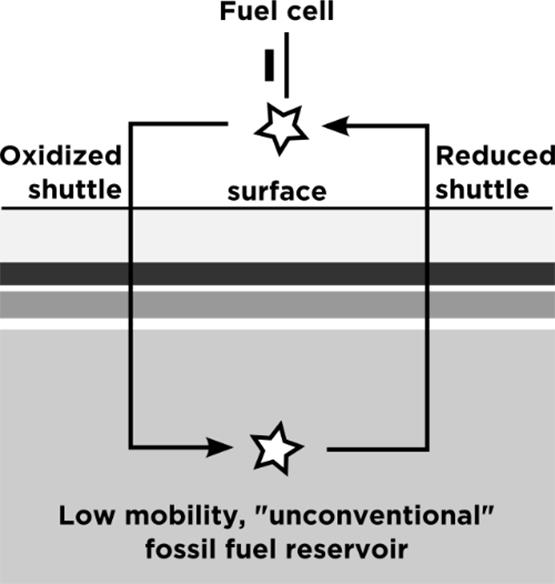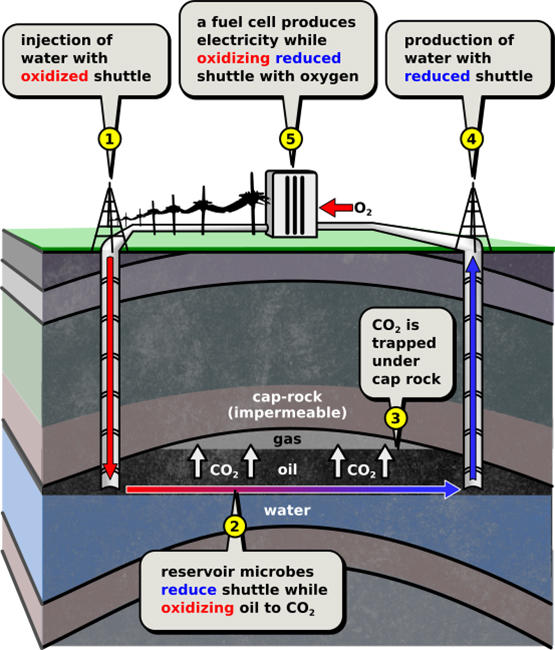SYZYGY
CFREF Theme 3. Project 1
Direct production of electricity from oil fields using electron shuttle systems
The greatest challenge facing humanity in the 21st century is the transition to a climate-neutral energy future. If limiting future global warming requires holding atmospheric CO2 concentrations below a target value, this inexorably leads to the conclusion that most of the world’s fossil fuels would have to remain underground. This is a challenge both for energy security and also for the economic security of countries that depend largely on fossil fuel production for their revenue. Many countries are currently implementing policy to reduce fossil fuel consumption. At the same time, technological progress is facilitating accelerated adoption of electrical vehicles and other more carbon neutral technologies. These developments will ultimately result in a reduced demand for oil and gas and the timescale for this reduction in demand is shortening.
Funded by CFREF (https://ucalgary.ca/energy/cfref), we had a team of around eight people currently looking at the options for direct power production from oil and gas fields, leaving carbon dioxide in the reservoir. We examined three routes, one an electron shuttle based system, the second an in reservoir, emplaceable electrode system, and we looked at conversion style processes linked to surface fuel cells.
At the University of Calgary, we have been developing approaches for the recovery of the energy in petroleum via microbial routes to produce energy vectors such as hydrogen, leaving carbon dioxide in the reservoir. This has resulted in several major scientific discoveries and spin out company’s, but the route has major technical obstacles to large-scale practicality. The general approaches are summarized in the review publications listed below (Head et al., 2014; Novotnik et al., 2020).
An idealized example of an elementary process scheme examined is depicted. A sulfate brine is injected into the reservoir via a well and moves through the reservoir toward a second well. Microbes, already present in the reservoir, use the sulfate to oxidize the fossil fuel molecules in situ, leading to the production of a sulfidic brine at the second well. The produced sulfide is reoxidized above-ground with atmospheric oxygen in a fuel cell or by combustion, yielding electricity. Sulfate is recycled to the first well and carbon dioxide is trapped under the cap-rock of the reservoir.
With many recent developments in reservoir biogeoscience and the assembly of a unique team with both a proven research and innovation track record, we carried out the research and technology development to assess at what scale such an approach could provide power for either local or grid scale use. Rather than focusing on the impractical sulphur based electron shuttle systems, we investigated the use of transition metal oxides, specifically those of manganese and iron, as solid electron acceptors for petroleum oxidation. The species and systems also have utility in other aspects of the project (electrodes, nanotechnology, fuel cells), beyond the shuttle based approaches.

The SYZYGY shuttles approach outlined in the diagram below, conceptually couples many of the aspects of large scale grid storage flow batteries, with large volumes of terminal reactants in tanks (oil in a reservoir and oxygen in the atmosphere) coupled to a fuel cell, with CO2 capture and storage in a reservoir (CCS), linked through a chemical looping oxidation-reduction vector-an electron shuttle. This alignment of technology elements is a SYZYGY, as is a true alignment of environmental, energy and economic objectives in the resolution of our EEE trilemma. We looked at several shuttle systems but especially at manganese, iron based systems and even organic electron shuttles such as quinone based systems. Our results suggest that while the approach works, it is not obviously scalable to significant power levels (Novotnik et al., 2020). Several other technologies from the project did emerge however including a novel redox cell now being developed for both flow battery and large scale carbon management purposes (Venkatesen et al., 2020).
Our project looked at biologically mediated syzygy processes but we also had a team looking at high temperature analogs using direct chemical oxidation of hydrocarbons in reservoirs at higher temperatures. That work continues.
The diagram below shows in essence how conceptually simple the shuttle approach is.

Our project explored the use of different shuttles including manganese and iron based electron shuttles. The research was challenging and addressed fundamental, current questions in microbiology, chemistry, materials science and geochemistry, as well as transport in porous media, reservoir engineering and process control and CO2 storage. We made several important discoveries relating to deep biosphere processes but a practical route to large scale electrical power generation from oilfields did not emerge. However we have more pots on the zero carbon stove so if you are thinking well beyond the limitations of current energy industry paradigms and technology development timelines, please contact us. We are especially interested in investors who are looking for game-changing solutions to our energy trilemma and are prepared to engage in business models that can actually achieve this on an aggressive timeline.
Contact Steve Larter (slarter@ucalgary.ca) or Mark Strous (mstrous@ucalgary.ca) for details.
Publications
Novotnik, Breda, et al. (2020). Can fossil fuel energy be recovered and used without any CO2 emissions to the atmosphere?. Reviews in Environmental Science and Bio/Technology 19.1 (2020): 217-240. https://link.springer.com/article/10.1007/s11157-020-09527-z
Venkatesan, S. et al., (2020). An auxiliary electrode mediated membrane-free redox electrochemical cell for energy storage. Sustainable Energy & Fuels, 4(5), pp.2149-2152 https://pubs.rsc.org/am/content/articlelanding/2020/se/c9se00734b/unauth#!divAbstract
Head, I. M., Gray, N. D., & Larter, S. R. (2014). Life in the slow lane; biogeochemistry of biodegraded petroleum containing reservoirs and implications for energy recovery and carbon management. Frontiers in Microbiology, 5, 566 https://www.frontiersin.org/articles/10.3389/fmicb.2014.00566/full
